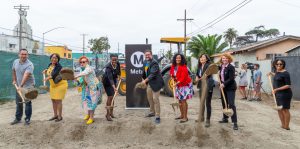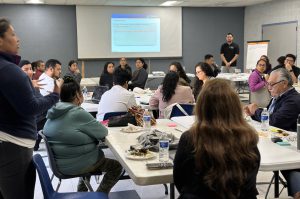
Celebrating 10 Years of SLATE-Z
Celebrating 10 Years of SLATE-Z A Legacy of Cultural Richness South Los Angeles has long been a place of cultural vibrancy, tracing its roots to
Variable Definitions:
Cash Public Assistance Income: The percentage of households receiving General Assistance or Temporary Assistance to Needy Families (TANF) in the past 12 months
Food Stamp/SNAP Benefits: The percentage of households receiving assistance from the Supplemental Nutrition Assistance Program (SNAP) in the past 12 months
Source:
American Community Survey, 5-year estimates, Table DP03
Years Available:
2010 – 2023
*Note: Each year of available data shown above is a 5-year estimate, or an average of data collected over a five year period. 5-year estimates are used to increase the reliability of the data at small geographies like neighborhoods and census tracts. The years shown on the NDSC map represent the final year of the five year average (e.g. “2010” represents 2006-2010 data, “2011” represents 2007-2011 data, and so on). For the most impactful comparison of data over time, the ACS recommends comparing non-overlapping years (e.g. 2010-14 with 2015-19).
Public assistance helps the most vulnerable people in our society. Understanding the rates at which households are receiving public assistance in any of these forms is fundamental to identifying regional inequities and designing solutions to alleviate poverty.The benefits cliff, or steep benefit reductions, refer to how an increase in a family’s income can result in a loss of eligibility for public assistance programs. Furthermore, families may experience marginal tax rates when an increase in their income increases their tax liability and loss of public benefits. In the eyes of policy-makers, the benefits cliff can disincentivize work, economic self-sufficiency, and promote marriage for benefits. Learn more about the benefits cliff from this 2021 report by the USC Price Center for Social Innovation.
Cash Public Assistance Income
Cash public assistance includes General Assistance (also called General Relief), which provides benefits to adults without children, and Temporary Assistance to Needy Families (TANF), which provides benefits to families with children. Policies for General Assistance vary by state and sometimes by county. Los Angeles County provides General Assistance (a maximum of $221 a month, last updated in 2019) to adults who don’t qualify for state or federal assistance. General Assistance may be time limited for individuals who are deemed able to work, and participation in employment services and substance use screenings, and criminal background checks are usually required to receive funds. TANF (called CalWORKs in California) is a program administered by state governments that provides cash aid and services to needy families to help pay for housing, food, utilities, clothes and medical care. States have flexibility to design their own programs, including the type and amount of assistance payments and rules for eligibility. California residents can qualify for CalWORKs if their family has $10,888 or less in resources ($16,333 if the family includes someone with a disability or someone 60 or over as of 2024). The amount a family receives is dependent on the number of people in a family, the monthly family income, and special needs of any family members.
Food Stamps/SNAP Benefits
The Supplemental Nutrition Assistance Program (SNAP) – called CalFresh in California – provides monthly food benefits to individuals and families with low incomes to help them afford more nutritious food. SNAP provides an essential hunger safety net in every state. The program issues monthly cash benefits on an Electronic Benefit Transfer (EBT) card, which can be used at any grocery store or farmers market who accepts EBT cards. The monthly amount an individual or family receives is dependent on their household size, income and other expenses such as housing and utilities. Most households must complete a gross income determination test in order to receive SNAP benefits. Gross Income is all non-excludable income from any source including earned income and all unearned income. The maximum income allowed is 200% of the Federal poverty level.
Supplemental Security Income
Supplemental Security Income (SSI) is a federally-run program that provides cash assistance (between $900 and $1000 per month) to people who are blind, disabled or elderly and who have little or no income. In California, qualifying individuals also receive a smaller payment from the state government to supplement the money the receive from the federal government. Unlike Social Security Income, which Americans pay into throughout their lives, there are no previous work requirements to receive SSI.
Written by Gabby Magaña
Citations:
“American Community Survey and Puerto Rico Community Survey 2017 Subject Definitions.” United States Census Bureau: American Community Survey, 2017. Link
“California Work Opportunity and Responsibility to Kids (CalWORKs).” State of California Department of Social Services. Link.
“General Relief Program Fact Sheet.” County of Los Angeles Department of Public Social Services. 2014. Link.
“CalFresh.” State of California Department of Social Services. Link.

Celebrating 10 Years of SLATE-Z A Legacy of Cultural Richness South Los Angeles has long been a place of cultural vibrancy, tracing its roots to

Advancing a Collaborative Agenda in Southeast LA In 2022, the California Community Foundation (CCF) launched the Regional Recovery Hub to strengthen place-based coordination in Los Angeles County

In 2022, the California Community Foundation (CCF) launched the Regional Recovery Hub to strengthen place-based coordination in Los Angeles County regions that were most heavily impacted by
